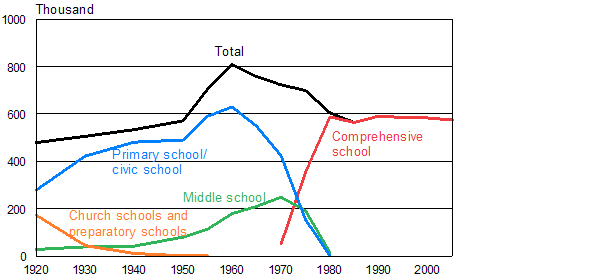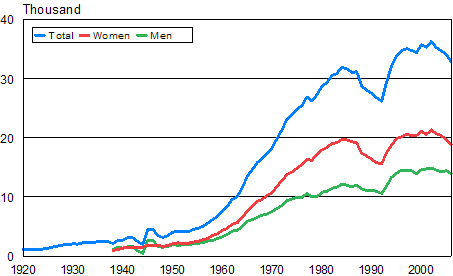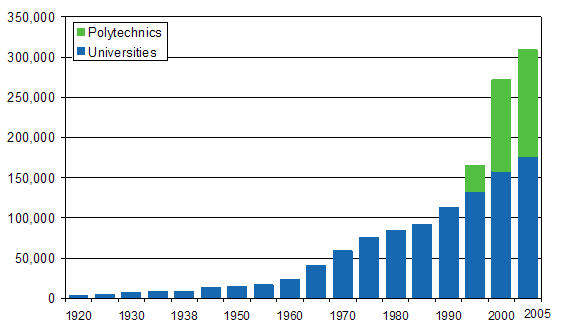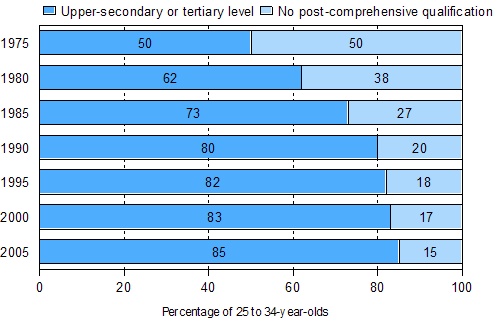Education in Finland: more education for more people
The educational level of Finland's population has risen steadily during the nine decades of independence. In the early years of independence, the challenge was to guarantee primary school education to all children. After the wars it became more common for children to go to middle and upper secondary general school, and as from the 1960s also tertiary level education expanded rapidly.
In Finland education has been seen as an important instrument of social ascent and personal development. The objective of education policy has been to guide the change of the educational system to respond to the needs of a changing society.
The continuously improving level of education of the population has contributed to the rise in the productivity of labour and, consequently, rapid economic and social development.
During its independence, Finland has evolved from a remote agricultural state into a state of high productivity and high technology, which has its place among the winners of international competition. An educated and competent labour force has been a key factor in this development process.
Compulsory School Attendance Act guarantees basic education
The Compulsory School Attendance Act was enacted soon after Finland gained its independence, and it entered into force in 1921. Compulsory education came to apply to all children aged 7 to 13, that is, compulsory schooling consisted of a primary school with 6 grades.
Gradually the Compulsory School Attendance Act extended primary education to cover the entire age group. In 1920 some 70 per cent of 15-year-olds were literate. The number of pupils in primary school started to rise quickly after the Act entered into force. Halfway through the 1930s, around 90 per cent of the 7 to 15-year-olds received schooling. Gradually education reached all children of statutory school age.
After the wars, the challenge was to fit all the children in the large age groups into primary schools. From 1950 to 1960 the number of pupils rose extremely quickly (Figure 1). The number of primary schools in rural areas reached its peak in the 1950s, but started to decline shortly after due to urbanisation. The number of primary schools in cities kept on increasing all the way until the 1960s.
Figure 1. Number of pupils in general basic education 1920-2005

As a consequence of regulations enacted in 1957 and 1958, two years of civic school were added to primary school, which then consisted of 8 grades. The discussion on the establishment of a comprehensive school started in the late 1950s with the introduction of the idea of a 9-year universally free municipal comprehensive school.
Under the system preceding the comprehensive school, pupils in the fourth grade applied for admission to secondary school, which opened up the route to further studies, e.g. the matriculation examination. Pupils not admitted to secondary school, or pupils whose parents could not afford or did not want to educate their children, stayed in primary school. Generally a fee had to be paid for attending secondary school.
The increasing wealth of families meant that more and more parents wanted their children to receive better education than before. Coming into the 1970s, already 60 per cent of the age group went on to middle school, that is, the lowest grades of secondary school.
A law on the basis of the education system was enacted in 1968, and the comprehensive school was established. The 9-grade comprehensive school was realised gradually over the 1970s. Currently statutory school age covers the age groups 7 to 16, and a person cannot be freed from it.
In the early 2000s, pre-primary education was reformed. As a result, all 6-year-old children are entitled to receive pre-primary education during the year before the start of their compulsory education. In 2006, nearly the entire age group, that is 58,000 children, attended voluntary pre-primary education for 6-year-olds.
Finnish 15-year-olds who have reached the end of their comprehensive education have excelled in the international PISA (Programme for International Students Assessment) study of learning results by being the best in the OECD countries in reading as well as in mathematics and natural sciences.
These days the Finnish comprehensive school is regarded abroad as an exemplary system, which produces good learning results at reasonable cost and whose learning results are also more equal than those in the OECD countries in general.
Secondary schools become more common
In 1930 Finland had a good 200 secondary schools. The number of secondary schools started to increase rapidly after the war. In 1950 they already numbered over 300, and in 1970 their number had exceeded 600.
Attending secondary school was rare up until 1920. Less than 10 per cent of the age group went to secondary school. Until the late 1930s, secondary school was the educational institution mostly for children from affluent city families.
In 1950 one-fourth and in 1960 just short of 40 per cent of the age group went to secondary school. Secondary schools received more pupils than before from families, where the parents had not attended secondary school. At the beginning of the 1970s, the number of children who started secondary school rose already to 60 per cent compared to the 11-year-old age group.
At the beginning of the 1950s, slightly less than 10 per cent of the age group entered upper secondary general school, i.e. the higher grades of secondary school. At around this time the rate of attendance at upper secondary general schools started to rise quickly. In 1960 slightly less than 20 per cent of the age group went to upper secondary general school, while in 1980 the share had climbed to 50 per cent.
During the school year 1970/1971, fifty-five per cent of pupils in upper secondary general school attended private educational institutions. The situation was, however, changed by the comprehensive school reform. The majority of state and private upper secondary general schools were taken over by the municipalities. During the school year 2005/2006, eight per cent of all upper secondary general school pupils attended private upper secondary general schools.
In the 2000s the annual number of entrants to upper secondary general school has exceeded 60 per cent when compared to the 16-year-old age group. At the beginning of the 2000s, a good 130,000 pupils attended upper secondary general school. In the most recent years, the number of pupils attending upper secondary general school has started to fall due to smaller age groups. In 2006 the number of pupils in upper secondary general school was 117,000.
In the 1930s the number of pupils who passed the matriculation examination was a good 2,000 per year, which was roughly 3 per cent of the age group. In 1950 a good 4,000 pupils passed the matriculation examination, but their number started to rise quickly. In 1963 the number of matriculation examinations exceeded 10,000, after 10 years the number was over 20,000 and in 1982 already over 30,000 (Figure 2).
Figure 2. Matriculation examinations in 1920-2006

Nearly 33,000 pupils passed the matriculation examination in 2006. The number of women who passed the examination exceeded that of men for the first time in 1947, if the exceptional conditions of the war years are not taken into account. At present, 58 per cent of the pupils who pass the matriculation examination are women.
Vocational education expands
Vocational education has also continuously expanded to guarantee ever better the basic skills required of the labour force. Vocational colleges were mainly established already during the late 19th century. Vocational school education started in the after war period. The Act on vocational schools was passed in 1958. The foundation of the network of vocational schools was formed of the general vocational schools, which could be attended after primary school. Educational institutions at the school level or upper secondary level evolved alongside vocational schools.
In the early 20th century, the number of students attending vocational education was 8,000. In 1940 they numbered about 20,000 and in 2005 the number of students attending some form of vocational education leading to a qualification was nearly 250,000.
Vocational education has undergone continuous change and development over the past decades. Currently it takes three years to obtain an initial vocational qualification. In recent years especially apprenticeship training and vocational education completed as a competence-based skills examination have increased and broadened the field of vocational education. Currently nearly one-half of vocational qualifications are completed as a competence-based skills examination.
New higher education institutions in the 1960s
In 1640 Finland's first university, the Academy of Turku, was founded. Its activities were, however, transferred to the new capital city, Helsinki, in 1827. The University of Helsinki remained Finland's only university for a long time. The beginning of the 20th century saw the founding of the University of Technology and the Helsinki School of Economics. After Finland became independent, Åbo Akademi, the University of Turku and Svenska Handelshögskolan started their operations. The number of students attending higher education grew steadily. In 1900, the University of Helsinki had 2,500 registered students, in 1920 all higher education institutions had a total of 3,600 students and in 1938, just before the Finno-Russo war, the number of students was about 9,000 (Figure 3).
Figure 3. Students attending higher education 1920-2005

In 1950 all higher education institutions had a good 14,000 students, and ten years later the threshold of 20,000 students had been exceeded.
The 1960s were the real decade of expanding higher education: several new higher education institutions were founded. During the decade, the Lappeenranta and Tampere Universities of Technology as well as the University of Joensuu and the Vaasa School of Economy were founded. The University of Social Sciences became the University of Tampere and the Institute of Pedagogics became the University of Jyväskylä. The University of Oulu started its operations in the late 1950s. The nationalisation of private higher education institutions realised in the 1970s was linked to the reform and regional expansion of the system of higher education.
At the end of the 1960s, the number of students attending higher education had reached nearly 60,000, that is, their number nearly trebled over one decade. The threshold of 100,000 students was exceeded in 1988. The number of students continued to grow rapidly in the 1990s, and at the end of the decade students in universities numbered more than 150,000. In 2006 there were nearly 180,000 university students.
In 1991 a new element, temporary polytechnics, was added to the tertiary level education sector. The last temporary polytechnics were made permanent in the early 2000s. At present some 130,000 students attend polytechnics. Polytechnic education has replaced vocational post-secondary and vocational tertiary level education.
Swift rise in the level of education
Increased education is reflected in the rapidly risen level of education in Finland. The number of people who have completed post-comprehensive level qualifications has risen from the roughly 300,000 persons in 1950 to 2.8 million in 2005.
In 1975 eleven percent of the persons aged 15 or over had completed a tertiary level qualification. In 2005 their share had already climbed to 25 per cent.
The level of education among young age groups has improved particularly quickly. In 1975 fifty per cent of the 25 to 34-year-olds had completed a post-comprehensive level qualification, and in 2005 the corresponding percentage was 85 (Figure 4).
Figure 4. Share of completers of post-comprehensive level qualifications of the 25 to 34-year-olds in 1975-2005

Inquiries: Mr Mika Tuononen +358 9 1734 3504
Sources and links
- Heikki Havén (1999): Kansanopetus. Article in the publication Suomen vuosisata. Statistics Finland, Helsinki. (In Finnish)
- Heikki Háven (1999): Lukio. Article in the publication Suomen vuosisata. Statistics Finland, Helsinki. (In Finnish)
- Juhani Honka (1999): Ammattikoulutus. Article in the publication Suomen vuosisata. Statistics Finland, Helsinki. (In Finnish)
- Sakari Ahola (1999): Yliopistot. Article in the publication Suomen vuosisata. Statistics Finland, Helsinki. (In Finnish)
- Osmo Lampinen (1999): Peruskoulutustaso. Article in the publication Suomen vuosisata. Statistics Finland, Helsinki. (In Finnish)
- Statistical Yearbook of Finland 1952-2006, Statistics Finland, Helsinki
- Oppilaitostilastot 2006, Koulutus 2007, Statistics Finland, Helsinki. (In Finnish)
- http://tilastokeskus.fi/til/kou_en.html
Last updated 12.11.2007
